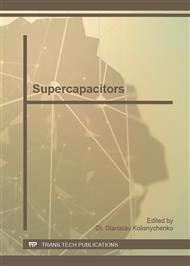p.338
p.342
p.346
p.356
p.361
p.367
p.372
p.376
p.381
Thermal Decomposition Synthesis of MoO3 for Application in Electrochemical Supercapacitors
Abstract:
MoO3 was synthesized by thermal decomposition of ammonium molybdate. The structure and surface morphology of the as-prepared MoO3 was characterized by X-ray diffraction (XRD) and scanning electron microscopy (SEM). The supercapacitive behaviour of MoO3 in 1 mol L-1 KCl electrolyte was studied by cyclic voltammetry (CV), galvanostatic charge-discharge cycling (CD). The affect of thermal decomposition temperature on the capacitive behaviour of MoO3 was also discussed here. The results indicate that MoO3 show good capacitive behaviour with a specific capacitance of 148.9 F g-1 at 0.7 A g-1. Thermal decomposition temperature has an important influence on the capacitive behaviour and crystallization of MoO3.
Info:
Periodical:
Pages:
361-364
Citation:
Online since:
August 2014
Authors:
Keywords:
Price:
Сopyright:
© 2014 Trans Tech Publications Ltd. All Rights Reserved
Share:
Citation:



